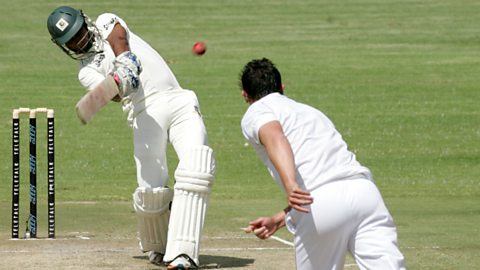Prevention of injury - reducing the risk
Risk of injury can be reduced by:
- following the rules of the game
- using personal protective equipment
- wearing the correct clothing and footwear
- warming up and cooling down
- using the appropriate level of competition
- lifting and carrying equipment safely
Rules of the game

A cricketer must follow all rules to ensure that injury is avoided. For example, a bowler must ensure that the ball bounces on the pitch and must bowl from behind the crease so that the batsperson has enough time to respond to the ball. Only a limited number of bowls each over may be delivered over shoulder height. These rules help to keep the batsperson safe.
Personal protective equipment
In cricket, a batsperson typically wears a helmet, pads and gloves in case a fast-moving ball strikes them. Likewise, some fielders such as the wicket keeper wear a helmet and pads for the legs. Many sports have rules to make sure protective equipment is worn. Other examples of personal protective equipment are shin pads, gum shields or mouth guards, buoyancy aids, chest pads and knee pads.

Correct clothing and footwear
Incorrect clothing and footwear can cause injury to the performer or an opponent. Clothing should always be appropriate for the activity, jewellery removed, hair tied back and laces tied. Footwear is very important and many sports require specialist shoes or boots. Football boots have studs for grip; astro trainers have soles which stick for turning safely; runners have spikes for grip and performance, but the length of the spikes are monitored as they can cause injury to others; triple jump shoes have extra protection for landing in the hop and step phases; basketball boots have extra ankle protection; road running shoes have soles to absorb repeated footstrike impact.
Use of warm up and cool down
Warming up the muscles and joints helps to prevent injury during training and competition, as they are better prepared for sudden movements. Cooling down effectively helps disperse lactic acid and restores muscles to their pre-exercise length, helping to reduce injury risk in the next session.
Appropriate level of competition
If competitors are not evenly matched or fairly balanced there is a greater risk of injury. Competitions are made safe and fair by the use of weight, age and gender categories or handicap systems.
Sports such as boxing and wrestling match opponents according to their weight, for example super heavyweight, flyweight, featherweight, welterweight.
Children's competitions are normally in age groups, as it wouldnāt be safe or fair to have a 15-year-old playing against a nine-year-old, especially in contact or team sports. Some adult sports also have veteran and senior categories for safety reasons.
In most sports, particularly contact sports, men play against men and women play against women - primarily for safety reasons.
Handicap systems are another way to make competition fairer, but are only occasionally used for safety reasons. 'Handicapping; makes the game harder for the better players and easier for novices. In golf, a better player would have to play a hole in fewer shots, whereas the novice would be allowed more shots without being penalised.
Lifting and carrying of equipment
To prevent injuries such as back strains and broken limbs, all large and dangerous equipment should be moved safely and correctly. Correct posture should be maintained throughout (bend knees, back flat and straight, keep weight/object close to body, extend legs to lift), and care taken when placing the equipment down to prevent foot injuries. Things like trampolines, vaulting boxes and moveable goalposts require training to set them up and put them away safely.